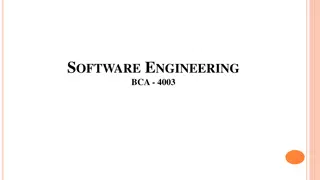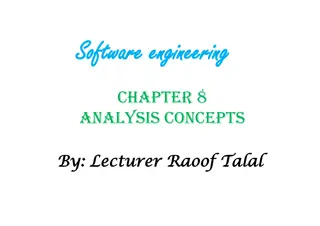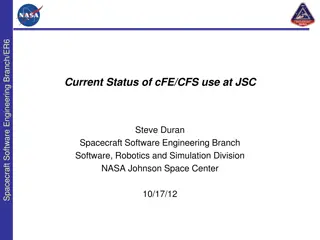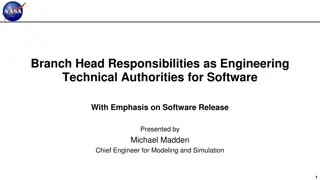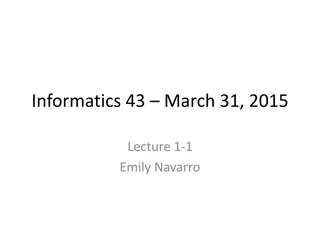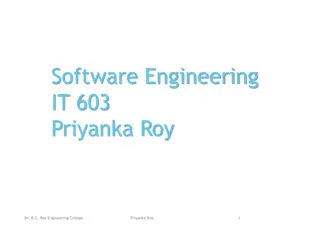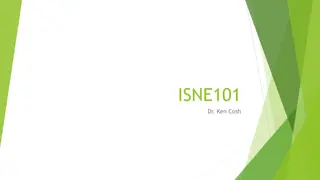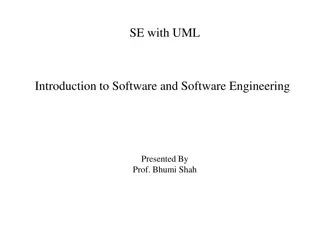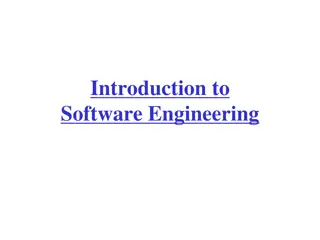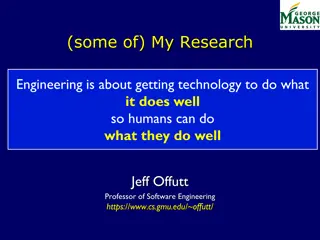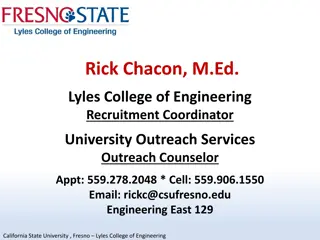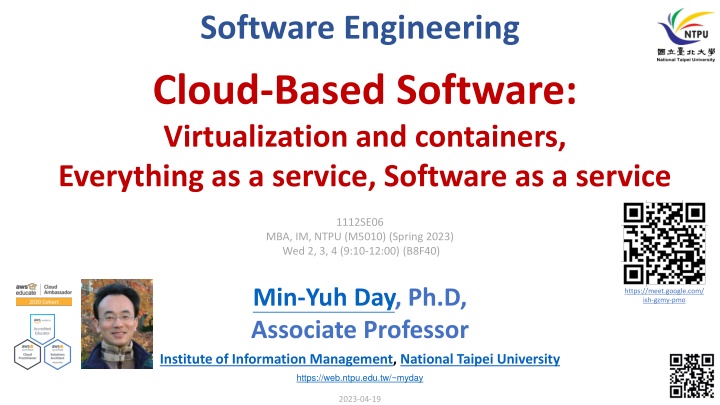
Cloud-Based Software Engineering and Project Management Overview
Explore the syllabus and schedule for the Cloud-Based Software Engineering course at NTPU, covering topics like virtualization, containers, agile methods, software architecture, and more. Dive into industry practices, security, microservices, and cloud computing in this comprehensive program. Stay updated on the latest trends in software engineering to enhance your skills and knowledge.
Download Presentation

Please find below an Image/Link to download the presentation.
The content on the website is provided AS IS for your information and personal use only. It may not be sold, licensed, or shared on other websites without obtaining consent from the author. If you encounter any issues during the download, it is possible that the publisher has removed the file from their server.
You are allowed to download the files provided on this website for personal or commercial use, subject to the condition that they are used lawfully. All files are the property of their respective owners.
The content on the website is provided AS IS for your information and personal use only. It may not be sold, licensed, or shared on other websites without obtaining consent from the author.
E N D
Presentation Transcript
Software Engineering Cloud-Based Software: Virtualization and containers, Everything as a service, Software as a service 1112SE06 MBA, IM, NTPU (M5010) (Spring 2023) Wed 2, 3, 4 (9:10-12:00) (B8F40) Min-Yuh Day, Ph.D, Associate Professor https://meet.google.com/ ish-gzmy-pmo Institute of Information Management, National Taipei University https://web.ntpu.edu.tw/~myday 1 2023-04-19
Syllabus Week Date Subject/Topics 1 2023/02/22 Introduction to Software Engineering 2 2023/03/01 Software Products and Project Management: Software product management and prototyping 3 2023/03/08 Agile Software Engineering: Agile methods, Scrum, and Extreme Programming 4 2023/03/15 Features, Scenarios, and Stories 5 2023/03/22 Case Study on Software Engineering I 6 2023/03/29 Software Architecture: Architectural design, System decomposition, and Distribution architecture 2
Syllabus Week Date Subject/Topics 7 2023/04/05 Tomb-Sweeping Day (Holiday, No Classes) 8 2023/04/12 Midterm Project Report 9 2023/04/19 Cloud-Based Software: Virtualization and containers, Everything as a service, Software as a service 10 2023/04/26 Cloud Computing and Cloud Software Architecture 11 2023/05/03 Microservices Architecture, RESTful services, Service deployment 12 2023/05/10 Security and Privacy; Reliable Programming; Testing: Test-driven development, and Code reviews; DevOps and Code Management: DevOps automation 3
Syllabus Week Date Subject/Topics 13 2023/05/17 Industry Practices of Software Engineering Software Industry Research Center, Market Intelligence & Consulting Institute (MIC)] [Agile Principles Patterns and Practices using AI and ChatGPT, Invited Speaker: Shihyu (Alex) Chu, Division Director, 14 2023/05/24 Case Study on Software Engineering II 15 2023/05/31 Final Project Report I 16 2023/06/07 Final Project Report II 17 2023/06/14 Self-learning 18 2023/06/21 Self-learning 4
Cloud-Based Software: Virtualization and containers, Everything as a service, Software as a service 5
Software Engineering and Project Management Design Test Deliver Build Analyze System and Software design Integration and system testing Operation and maintenance Implementation and unit testing Requirements definition Project Management 6
Information Management (MIS) Information Systems Organizations Technology Information Systems Management 7 Source: Kenneth C. Laudon & Jane P. Laudon (2014), Management Information Systems: Managing the Digital Firm, Thirteenth Edition, Pearson.
Fundamental MIS Concepts Business Challenges Management Information System Business Solutions Organization Technology 8 Source: Kenneth C. Laudon & Jane P. Laudon (2014), Management Information Systems: Managing the Digital Firm, Thirteenth Edition, Pearson.
Project-based software engineering CUSTOMER Problem generates helps-with implemented-by 1 Software Requirements CUSTOMER and DEVELOPER Source: Ian Sommerville (2019), Engineering Software Products: An Introduction to Modern Software Engineering, Pearson. DEVELOPER 9
Product software engineering DEVELOPER 1 Opportunity inspires realizes implemented-by Product features Software DEVELOPER DEVELOPER 10 Source: Ian Sommerville (2019), Engineering Software Products: An Introduction to Modern Software Engineering, Pearson.
Software execution models Stand-alone execution Hybrid execution Software as a service User s computer User s computer User s computer User interface Product functionality User data User interface Partial functionality User data User interface (browser or app) Additional functionality User data backups Product updates Product functionality User data Product updates Vendor s servers Vendor s servers Vendor s servers Source: Ian Sommerville (2019), Engineering Software Products: An Introduction to Modern Software Engineering, Pearson.
Product management concerns Business needs Product manager Technology constraints Customer experience 12 Source: Ian Sommerville (2019), Engineering Software Products: An Introduction to Modern Software Engineering, Pearson.
Technical interactions of product managers Product vision management Product backlog management User stories and scenarios Product manager Acceptance testing Customer testing User interface design 13 Source: Ian Sommerville (2019), Engineering Software Products: An Introduction to Modern Software Engineering, Pearson.
Software Development Life Cycle (SDLC) The waterfall model Requirements definition System and Software design Implementation and unit testing Integration and system testing Operation and maintenance 14 Source: Ian Sommerville (2015), Software Engineering, 10th Edition, Pearson.
Plan-based and Agile development Plan-based development Requirements engineering Requirements specification Design and implementation Requirements change requests Agile development Requirements engineering Design and implementation 15 Source: Ian Sommerville (2015), Software Engineering, 10th Edition, Pearson.
The Continuum of Life Cycles High Incremental Agile Frequency of Delivery Predictive Iterative Low Low High Degree of Change 16 Source: Project Management Institute (2017), Agile Practice Guide, Project Management Institute
Predictive Life Cycle Analyze Design Build Test Deliver 17 Source: Project Management Institute (2017), Agile Practice Guide, Project Management Institute
Iterative Life Cycle Refine Prototype Analyze Design Build Test Analyze Deliver 18 Source: Project Management Institute (2017), Agile Practice Guide, Project Management Institute
A Life Cycle of Varying-Sized Increments Analyze Design Build Test Deliver Analyze Design Build Test Deliver Analyze Design Build Test Deliver 19 Source: Project Management Institute (2017), Agile Practice Guide, Project Management Institute
Iteration-Based and Flow-Based Agile Life Cycles Iteration-Based Agile Requirements Analysis Design Build Test Requirements Analysis Design Build Test Requirements Analysis Design Build Test Requirements Analysis Design Build Test Requirements Analysis Design Build Test Requirements Analysis Design Build Test Repeat as needed Flow-Based Agile Requirements Analysis Design Build Test the number of features in the WIP limit Requirements Analysis Design Build Test the number of features in the WIP limit Requirements Analysis Design Build Test the number of features in the WIP limit Requirements Analysis Design Build Test the number of features in the WIP limit Requirements Analysis Design Build Test the number of features in the WIP limit Repeat as needed 20 Source: Project Management Institute (2017), Agile Practice Guide, Project Management Institute
From personas to features 1 Personas A way of representing users inspire Natural language descriptions of a user interacting with a software product are-developed-into Scenarios 2 3 inspire Natural language descriptions of something that is needed or wanted by users Stories 4 Features define Fragments of product functionality 21 Source: Ian Sommerville (2019), Engineering Software Products: An Introduction to Modern Software Engineering, Pearson.
Multi-tier client-server architecture Client 1 Client 2 Web Server Application Server Database Server Client 3 Client 22 Source: Ian Sommerville (2019), Engineering Software Products: An Introduction to Modern Software Engineering, Pearson.
Service-oriented Architecture Client 1 S1 S2 Client 2 S3 Web Server Service gateway S4 Client 3 S5 S6 Client Services 23 Source: Ian Sommerville (2019), Engineering Software Products: An Introduction to Modern Software Engineering, Pearson.
VM Container Virtual web server Virtual mail server User 1 Container 1 User 2 Container 2 Server software Application software Application software Server software Guest OS Server software Server software Guest OS Hypervisor Container manager Host OS Host OS Server Hardware Server Hardware 24 Source: Ian Sommerville (2019), Engineering Software Products: An Introduction to Modern Software Engineering, Pearson.
Everything as a service Logistics management Software as a service (SaaS) Photo editing Database Software development Cloud Platform as a service (PaaS) management Monitoring Storage Network Infrastructure as a service (IaaS) Computing Virtualization Cloud data center 25 Source: Ian Sommerville (2019), Engineering Software Products: An Introduction to Modern Software Engineering, Pearson.
Software as a service Software customers Software provider Software services Cloud provider Cloud Infrastructure 26 Source: Ian Sommerville (2019), Engineering Software Products: An Introduction to Modern Software Engineering, Pearson.
Microservices architecture key design questions What are the microservices that make up the system? How should microservices communicate with each other? How should data be distributed and shared? Microservices architecture design How should the microservices in the system be coordinated? How should service failure be detected, reported and managed? 27 Source: Ian Sommerville (2019), Engineering Software Products: An Introduction to Modern Software Engineering, Pearson.
Types of security threat An attacker attempts to deny access to the system for legitimate users An attacker attempts to damage the system or its data Integrity threats Availability threats SOFTWARE PRODUCT PROGRAM Distributed denial of service (DDoS) attack Virus DATA Ransomware Data theft Confidentiality threats An attacker tries to gain access to private information held by the system 28 Source: Ian Sommerville (2019), Engineering Software Products: An Introduction to Modern Software Engineering, Pearson.
Software product quality attributes 1 2 Reliability Availability 7 3 Software product quality attributes Security Resilience 6 4 5 Usability Maintainability Responsiveness 29 Source: Ian Sommerville (2019), Engineering Software Products: An Introduction to Modern Software Engineering, Pearson.
A refactoring process 1 2 Start Identify refactoring strategy Identify code smell 4 3 Make small improvement until strategy completed Run automated code tests 30 Source: Ian Sommerville (2019), Engineering Software Products: An Introduction to Modern Software Engineering, Pearson.
Functional testing Start 1 Unit Testing 2 4 Release Testing Feature Testing 3 System Testing 31 Source: Ian Sommerville (2019), Engineering Software Products: An Introduction to Modern Software Engineering, Pearson.
Test-driven development (TDD) 1 Start Identify new functionality 2 Identify partial implementation of functionality 3 Write code stub that will fail test Functionality complete Functionality incomplete 4 Run all automated test 7 Refactor code if required 5 Implement code that should cause failing test to pass Test failure 6 Run all All tests pass automated test 32 Source: Ian Sommerville (2019), Engineering Software Products: An Introduction to Modern Software Engineering, Pearson.
DevOps Development Deployment Support Multi-skilled DevOps team 33 Source: Ian Sommerville (2019), Engineering Software Products: An Introduction to Modern Software Engineering, Pearson.
Code management and DevOps DevOps automation Continuous integration Continuous deployment Continuous delivery Infrastructure as code Code management system Branching and merging Save and retrieve versions Recover version information Code repository Transfer code to/from developer s filestore DevOps measurement Data collection Data analysis Report generation 34 Source: Ian Sommerville (2019), Engineering Software Products: An Introduction to Modern Software Engineering, Pearson.
Cloud-Based Software: Virtualization and containers, Everything as a service, Software as a service 35
The cloud The cloud is made up of very large number of remote servers that are offered for rent by companies that own these servers. Cloud-based servers are virtual servers , which means that they are implemented in software rather than hardware. 36 Source: Ian Sommerville (2019), Engineering Software Products: An Introduction to Modern Software Engineering, Pearson.
The cloud You can rent as many servers as you need, run your software on these servers and make them available to your customers. Cloud servers can be started up and shut down as demand changes. You may rent a server and install your own software, or you may pay for access to software products that are available on the cloud. 37 Source: Ian Sommerville (2019), Engineering Software Products: An Introduction to Modern Software Engineering, Pearson.
Cloud Software: Scaleability, elasticity and resilience Scaleability Maintain performance as load increases Elasticity Adapt the server configuration to changing demands Cloud software characteristics Resilience Maintain service in the event of server failure 38 Source: Ian Sommerville (2019), Engineering Software Products: An Introduction to Modern Software Engineering, Pearson.
Scaleability Scaleability reflects the ability of your software to cope with increasing numbers of users. As the load on your software increases, your software automatically adapts so that the system performance and response time is maintained. 39 Source: Ian Sommerville (2019), Engineering Software Products: An Introduction to Modern Software Engineering, Pearson.
Elasticity Elasticity is related to scaleability but also allows for scaling-down as well as scaling-up. You can monitor the demand on your application and add or remove servers dynamically as the number of users change. 40 Source: Ian Sommerville (2019), Engineering Software Products: An Introduction to Modern Software Engineering, Pearson.
Resilience Resilience means that you can design your software architecture to tolerate server failures. You can make several copies of your software concurrently available. If one of these fails, the others continue to provide a service. 41 Source: Ian Sommerville (2019), Engineering Software Products: An Introduction to Modern Software Engineering, Pearson.
Benefits of using the cloud for software development Cost You avoid the initial capital costs of hardware procurement Startup time Using the cloud, you can have servers up and running in a few minutes. Server choice If you find that the servers you are renting are not powerful enough, you can upgrade to more powerful systems. You can add servers for short-term requirements, such as load testing. Distributed development If you have a distributed development team, working from different locations, all team members have the same development environment and can seamlessly share all information. 42 Source: Ian Sommerville (2019), Engineering Software Products: An Introduction to Modern Software Engineering, Pearson.
Virtual cloud servers A virtual server runs on an underlying physical computer and is made up of an operating system plus a set of software packages that provide the server functionality required. A virtual server is a stand-alone system that can run on any hardware in the cloud. This run anywhere characteristic is possible because the virtual server has no external dependencies. 43 Source: Ian Sommerville (2019), Engineering Software Products: An Introduction to Modern Software Engineering, Pearson.
Virtual cloud servers Virtual machines (VMs), running on physical server hardware, can be used to implement virtual servers. A hypervisor provides hardware emulation that simulates the operation of the underlying hardware. If you use a virtual machine to implement virtual servers, you have exactly the same hardware platform as a physical server. 44 Source: Ian Sommerville (2019), Engineering Software Products: An Introduction to Modern Software Engineering, Pearson.
Implementing a virtual server as a Virtual Machine (VM) Virtual web server Virtual mail server Server software Apache Web Server Server software Outlook Guest OS Guest OS Windows Server Linux Hypervisor Host OS Server Hardware 45 Source: Ian Sommerville (2019), Engineering Software Products: An Introduction to Modern Software Engineering, Pearson.
Container-based virtualization If you are running a cloud-based system with many instances of applications or services, these all use the same operating system, you can use a simpler virtualization technology called containers . Using containers accelerates the process of deploying virtual servers on the cloud. Containers are usually megabytes in size whereas VMs are gigabytes. Containers can be started and shut down in a few seconds rather than the few minutes required for a VM. 46 Source: Ian Sommerville (2019), Engineering Software Products: An Introduction to Modern Software Engineering, Pearson.
Container-based virtualization Containers are an operating system virtualization technology that allows independent servers to share a single operating system. They are particularly useful for providing isolated application services where each user sees their own version of an application. 47 Source: Ian Sommerville (2019), Engineering Software Products: An Introduction to Modern Software Engineering, Pearson.
Using containers to provide isolated services User 1 Container 1 Container 2 User 2 Graphic design Software Graphic design Software Application software Application software Graphics libraries Photo Manager Graphics libraries Photo Manager Server software Server software Container manager Host OS Server Hardware 48 Source: Ian Sommerville (2019), Engineering Software Products: An Introduction to Modern Software Engineering, Pearson.
VM Container Virtual web server Virtual mail server User 1 Container 1 User 2 Container 2 Server software Application software Application software Server software Guest OS Server software Server software Guest OS Hypervisor Container manager Host OS Host OS Server Hardware Server Hardware 49 Source: Ian Sommerville (2019), Engineering Software Products: An Introduction to Modern Software Engineering, Pearson.
Docker Containers were developed by Google around 2007 but containers became a mainstream technology around 2015. An open-source project called Docker provided a standard means of container management that is fast and easy to use. Docker is a container management system that allows users to define the software to be included in a container as a Docker image. It also includes a run-time system that can create and manage containers using these Docker images. 50 Source: Ian Sommerville (2019), Engineering Software Products: An Introduction to Modern Software Engineering, Pearson.

